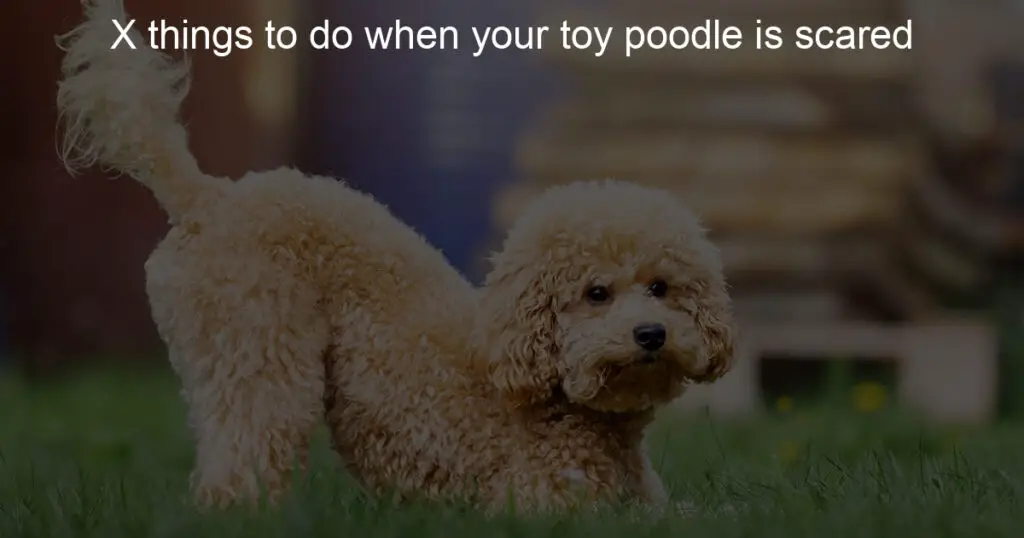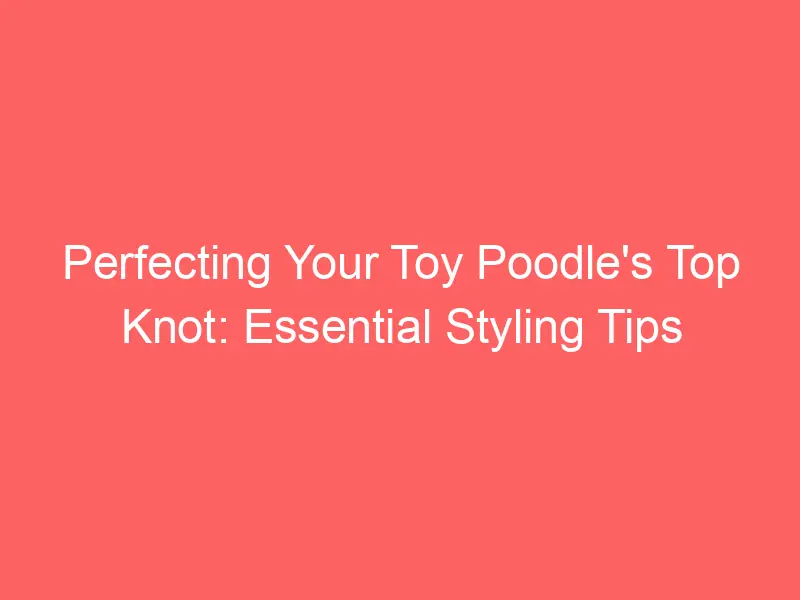Understanding Your Scared Toy Poodle

Toy Poodles are known for their intelligence and charm, but like all dogs, they can experience fear and anxiety. Understanding your scared Toy Poodle is the first step towards helping them feel safe and secure. In this section, we will discuss how to recognize the signs of fear in your Toy Poodle, understand the causes of their anxiety, and how fear affects their behavior.
-
- Recognizing the signs of fear in your toy poodle
Toy Poodles, like other dogs, express fear through certain behaviors. They may shake, hide, or become aggressive. They might also show subtle signs like excessive licking or yawning, changes in body posture, or avoiding eye contact. It’s important to pay attention to these signs as they can indicate that your Toy Poodle is feeling scared or anxious.
-
- Understanding the causes of toy poodle anxiety
There are many reasons why a Toy Poodle might feel scared. Common causes include loud noises, unfamiliar environments, or traumatic experiences. Sometimes, fear can also be a result of poor socialization or lack of training. Understanding the root cause of your Toy Poodle’s fear is crucial in helping them overcome their anxiety.
-
- How fear affects toy poodle behavior
Fear can have a significant impact on your Toy Poodle’s behavior. It can lead to aggression, destructive behavior, or withdrawal. In some cases, fear can also cause physical symptoms like diarrhea or loss of appetite. It’s important to understand that these behaviors are a response to fear, and not a sign of disobedience or bad behavior.
In conclusion, understanding your scared Toy Poodle involves recognizing the signs of fear, understanding the causes of their anxiety, and knowing how fear affects their behavior. By doing so, you can help your Toy Poodle feel safe and secure, and maintain a healthy and happy relationship with them.
Dealing with Your Scared Toy Poodle
Dealing with a scared toy poodle can be a challenging task. However, with the right approach and techniques, you can help your furry friend overcome its fears. Here are some calming techniques that can help your scared toy poodle feel more at ease.
Calming Techniques for Your Scared Toy Poodle
Understanding how to calm your scared toy poodle is crucial in helping them overcome their fears. Here are some strategies you can use:
- Creating a safe space for your toy poodle: A safe space can provide a sense of security for your scared toy poodle. This could be a quiet room or a comfortable crate where your poodle can retreat when feeling scared. Ensure this space is free from loud noises and sudden movements that can startle your pet.
- Using calming music to soothe your scared toy poodle: Music has a calming effect on dogs, just like it does on humans. Playing soft, soothing music can help reduce your toy poodle’s anxiety. There are even special music compilations designed specifically for dogs that you can use.
- Implementing regular exercise to manage toy poodle anxiety: Regular exercise can help manage your toy poodle’s anxiety by burning off excess energy and promoting a sense of calm. Try to incorporate daily walks or play sessions into your poodle’s routine. Remember, a tired dog is a happy dog!
By implementing these calming techniques, you can help your scared toy poodle feel more secure and less anxious. Remember, patience and consistency are key when dealing with a scared pet. With time and effort, your toy poodle will learn to trust and feel safe in its environment.
Training Techniques to Help Your Scared Toy Poodle
Training your toy poodle can be a challenging task, especially if they are scared or anxious. However, with the right techniques, you can help your furry friend overcome their fears and build confidence. Here are three effective training techniques:
-
- Using Positive Reinforcement to Encourage Confidence
Positive reinforcement involves rewarding your toy poodle for good behavior. This can be in the form of treats, praises, or petting. According to a study, dogs trained with positive reinforcement showed fewer signs of fear and anxiety. Start by rewarding your toy poodle for small achievements and gradually increase the challenges. Remember, consistency is key in this process.
-
- Gradual Exposure to Reduce Fear in Your Toy Poodle
Gradual exposure, also known as desensitization, involves slowly introducing your toy poodle to the things they fear. Start with a low level of the fear-inducing stimulus and gradually increase its intensity as your dog becomes comfortable. This technique helps your toy poodle to associate the fear-inducing stimulus with positive experiences, thereby reducing their fear.
-
- Seeking Professional Help When Necessary
If your toy poodle’s fear seems to be beyond your control, it’s advisable to seek professional help. A professional dog trainer or a veterinary behaviorist can provide tailored strategies to help your toy poodle overcome their fears. They can also help you understand the root cause of your dog’s fear, which is crucial in managing it effectively.
In conclusion, training your scared toy poodle requires patience, consistency, and understanding. With the right techniques, you can help your toy poodle overcome their fears and live a happy, confident life.
Preventing Fear in Your Toy Poodle
Preventing fear in your toy poodle is an essential part of their overall wellbeing. A fear-free environment allows your pet to live a happy, healthy, and fulfilling life. Here are some strategies to help you build a fear-free environment for your toy poodle.
Building a Fear-Free Environment for Your Toy Poodle
Creating a fear-free environment for your toy poodle involves more than just providing them with food and shelter. It’s about creating a safe, comfortable space where they feel secure and loved. Here are some ways to achieve this:
- Ensuring a consistent routine for your toy poodle: Dogs thrive on routine. Consistency in feeding times, walks, and playtimes can help your toy poodle feel secure and less anxious. A predictable routine can help reduce fear and anxiety in your pet.
- Introducing new experiences gradually: New experiences can be scary for your toy poodle. Whether it’s a new person, a new pet, or a new environment, introduce these changes gradually. This will give your toy poodle time to adjust and prevent them from becoming overwhelmed and fearful.
- Maintaining a calm household to prevent toy poodle anxiety: A calm and peaceful household can significantly reduce your toy poodle’s fear and anxiety. Avoid loud noises, sudden movements, and other potential stressors that can scare your toy poodle. Instead, create a calm, quiet environment where your pet feels safe and secure.
Preventing fear in your toy poodle is not just about managing their immediate reactions. It’s about creating an environment that promotes their long-term emotional health. By following these strategies, you can help your toy poodle live a fear-free, happy life.
Case Studies: Successful Fear Management in Toy Poodles
In this section, we will explore real-life examples of how toy poodles have successfully overcome their fears. These case studies will provide practical insights and strategies that you can apply to help your toy poodle manage its fears.
Case Study 1: Overcoming Separation Anxiety in a Toy Poodle
Separation anxiety is a common issue among toy poodles. This case study focuses on a toy poodle named Bella who struggled with severe separation anxiety.
-
- Identifying the problem:
Bella’s owner noticed that she would become extremely anxious whenever she was left alone. She would bark incessantly, chew on furniture, and even have accidents in the house. After consulting with a vet, it was confirmed that Bella was suffering from separation anxiety.
-
- Implementing a solution:
Bella’s owner started by gradually increasing the amount of time Bella spent alone. They began with just a few minutes at a time and slowly worked up to longer periods. They also provided Bella with plenty of toys and activities to keep her occupied when they were not home. Additionally, they ensured Bella got plenty of exercise and attention when they were home, to help reduce her anxiety.
-
- Results and key takeaways:
With time and patience, Bella’s separation anxiety significantly improved. She no longer exhibited destructive behaviors when left alone and seemed much happier and more relaxed. The key takeaway from this case study is that gradual exposure combined with plenty of mental and physical stimulation can effectively manage separation anxiety in toy poodles.
Understanding your dog’s fear and implementing a tailored solution can make a significant difference in their quality of life. Remember, every dog is unique, and what works for one may not work for another. It’s essential to be patient and persistent in your efforts.
Case Study 2: Helping a Toy Poodle Overcome Fear of Loud Noises
In this case study, we will explore a common fear among Toy Poodles – loud noises. We will discuss how we identified the problem, implemented a solution, and the key takeaways from this experience.
-
- Identifying the problem
Our subject, a two-year-old Toy Poodle named Bella, showed signs of distress whenever she encountered loud noises. This included thunderstorms, fireworks, and even loud household appliances. Bella would tremble, hide, and sometimes even refuse to eat. After observing these symptoms, it was clear that Bella had a fear of loud noises.
-
- Implementing a solution
We decided to use a technique called desensitization and counter-conditioning. This involved gradually exposing Bella to the noises she feared in a controlled environment, starting with low volume and gradually increasing it. At the same time, we associated these noises with positive experiences, like treats and playtime. This process required patience and consistency.
-
- Results and key takeaways
After several weeks of consistent training, Bella’s fear of loud noises significantly decreased. She no longer hid or trembled during thunderstorms or when the vacuum cleaner was in use. The key takeaway from this case study is that with patience and the right techniques, it’s possible to help a Toy Poodle overcome their fear of loud noises. However, it’s important to remember that each dog is unique and what works for one may not work for another.
In conclusion, understanding and addressing your Toy Poodle’s fears is crucial for their well-being. With patience, consistency, and the right techniques, you can help your furry friend live a happier, fear-free life.
Conclusion: Your Role in Managing Your Toy Poodle’s Fear
As we conclude, it’s essential to understand that managing your toy poodle’s fear is a journey that requires your active participation. Here are some key points to remember:
- Emphasizing patience and understanding: Your toy poodle may not overcome its fears overnight. It’s important to be patient and understanding during this process. Remember, your pet can sense your emotions, so maintaining a calm and supportive demeanor can help them feel more secure.
- Continued learning about toy poodle behavior: Understanding your poodle’s behavior is crucial in managing their fear. Spend time learning about their specific triggers and how they express fear. This knowledge can help you create a safer and more comfortable environment for your pet. For more information, you can visit the Poodle page on Wikipedia.
- Seeking professional help when necessary: If your toy poodle’s fear seems to be escalating or causing significant distress, don’t hesitate to seek professional help. A veterinarian or a professional dog trainer can provide valuable insights and strategies to help manage your pet’s fear.
In conclusion, your role in managing your toy poodle’s fear is pivotal. By emphasizing patience and understanding, continuing to learn about your poodle’s behavior, and seeking professional help when necessary, you can help your furry friend live a happy and fear-free life.














